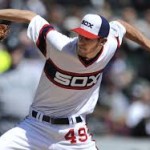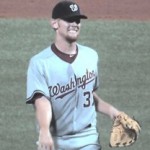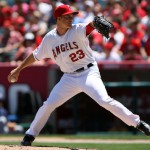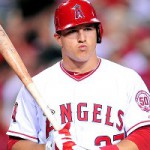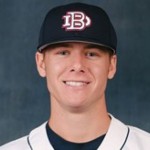
Jake Johansen led the Nats 2013 draft. Photo via DBU website
Last year, minorleagueball.com’s John Sickels started a quick-hit review of every 2012 draft pick with snap judgements and quick stats. I thought it was a great project, a nice little way to see how the draft picks were faring. He petered out around the 17th round, and I took up his cause for just the Nationals picks and went through all 40 rounds at this link here. Apparently 2012’s project was too much work for Sickels; he doesn’t seem to be doing it this year. So I picked up the torch and did a Sickels-style analysis for all 40 of the Nats 2013 draft picks below.
(Note: stats are pulled from milb.com and/or fangraphs.com; put the player name into the search bar to get his seasonal stats). MILB has nice consolidated seasonal stats while fangraphs has better advanced stats. They do not include any playoff stats for those still playing after 9/2/13).
Finally, at the end of each writeup i’ll put in a color coded trending line for the player: Green for Trending Up, Blue for Trending steady, red for Trending Down. This is just my knee-jerk opinion of the prospect status of the player system-wide. And yes I realize this is their first pro ball season, short-sample sizes, etc etc.
Without further ado:
Round 1: forfeited w/ Rafael Soriano signing, which as I noted in this June 2013 post cost the Nats a shot at one of several highly regarded pitchers drafted just behind our vacated spot.
Round 2: Jake Johansen, Coll Sr. RH Starting Pitcher. 1-3, 1.92 ERA with 51/23 K/BB in 51 2/3 innings between Auburn and Hagerstown, 34 hits. After signing quickly for slot (very quickly, like in 24 hours or so), Johansen joined short-A Auburn and was essentially unhittable through 10 starts. He was promoted up to low-A, got hit around in two starts and finishes the season with a 1.92 ERA, and a sub 1.00 WHIP. Johansen outperformed his poor college numbers somewhat, still walks too many batters, and still flashes a dominant fastball. Scouts continue to believe he’ll end up in the bullpen, but until that situation presents itself Johansen will stay as a starter. He seems like he’s bound for the opening day start in Hagerstown in 2014. Trending Up.
Round 3: Drew Ward, HS 3B. .292/.402/.387 with one homer, 25 walks, 44 strikeouts in 168 at-bats for the GCL Nats in the rookie league. A good average and a great OBP, but where’s the power? Ward was reported to have a ton of power coming up but his slugging was lower than his OBP. He produced at a 142 wRC+ for the season, which is great, but I think he needs to show more power going forward. That won’t be easy in his next stop; the stadium in Hagerstown is old and cavernous with huge walls; you earn every homer up there. Trending Up.
Round 4: Nick Pivetta, Juco RH Starting Pitcher. 1-1, 3.41 ERA with 18/12 K/BB in 29 innings between GCL and Short-A, 28 hits. Pivetta started 8 games but averaged less than 4 innings a start. For such a big guy (6’5″ 220) with such a reported fastball (upper 90s in short spurts) I would have hoped for more K’s (18 in 29 innings). Outlook; bound for Hagerstown but seems like someone who may convert to short relief soon where he can maintain higher velocity in shorter outings. Trending Steady.
Round 5: Austin Voth, Coll Jr RH Starting Pitcher: 3-0, 1.75 ERA with 55/6 K/BB in46 1/3 innings between three levels, 33 hits. You read that correctly; 55 to 6 strike out to walk ratio for this U of Washington product. He pushed his way through two promotions on the season, ending up in the Hagerstown rotation. Another interesting stat: Zero home-runs in his 55 innings on the year. And these stats were done with pretty normal looking BABIPs; his FIP values were lower than his ERAs in short- and low-A. He seems like an exciting draft find and should be in the Hagerstown rotation in 2014. Trending Up.
Round 6: Cody Gunter, Juco 3B. .229/.294/.313 with 3 homers, 20 walks, 62 strikeouts in 214 at-bats for Auburn. 62 punchouts out of 214 at-bats; that’s more than 25%. With so many Ks and so little power (.084 ISO), I’d be concerned about Gunter’s future at the corner. Its possible he was just a bit young for Auburn as a 1st-year JuCo grad. Trending down.
Round 7: Jimmy Yezzo, Coll Jr 1B. .267/.282/.342 with 2 homers, 5 walks, 37 strikeouts in 243 at-bats for Auburn. Five walks in 243 at-bats?? That shows a pretty significant plate discipline issue. Yezzo came to the Nats with such a good hitting reputation in a decent baseball conference (the CAA); what has happened? Drafted as a first baseman, Yezzo needs to show some serious power improvement to continue at a spot which normally is where lesser defenders “end up” to keep their bat in the lineup. Trending down.
Round 8: David Napoli, Coll Sr LH relief pitcher. 1-0, 1.14 ERA with 28/10 K/BB in23 relief innings in Auburn, 16 hits. He had a very wild reputation coming out of college, but seems to have toned it down at Auburn to become an excellent relief pitcher. I’m a little disappointed to see him already get converted to relief, but his size and stuff seems to point towards situational lefty anyway. I could see him in Potomac in 2014 quickly turning into the next Ian Krol. Trending up.
Round 9: Jake Joyce, Coll Sr RH relief pitcher. 1-3, 5.22 ERA with 25/12 K/BB in 29 relief innings in Auburn, 37 hits. Joyce was unlucky (.381 babip) and his FIP reflects that (3.03 versus 5.22 era), but he still gave up a ton of base-runners (1.67 whip) and a ton of air-outs (0.62 GO/AO on the year). Given the fact that Joyce was a senior sign for very little money, he could seem rather expendible if he doesn’t start strong in 2014. Trending down.
Round 10: Brennan Middleton, Coll Sr SS/2B. Did not play an inning in 2013; I cannot find any details of the injury. There are some reports that he injured his ankle towards the end of his senior season at Tulane; perhaps that injury carried over into the summer. He signed for a pittance and was not highly regarded; he could struggle to make a team out of spring. Trending down.
A quick note before continuing: you can see the effect very clearly of the new MLB draft rules by looking at the Nats draft picks here; our 8th,9th and 10th round guys signed for a combined $40,000 so the team could over-pay earlier in the draft. We got mostly cheap guys, senior signs with zero leverage as we got closer to the 10th round and the production shows. Then, starting at round 11 (where the slot per pick is a flat $100,000 and the signing bonus cap re-sets) we start to see more significant prospects get signed and coaxed out of remaining college eligibility. Its almost as if we should treat the 8th-10th rounders as closer to 30th round picks, all things considered.
Round 11: John Simms, Coll jr RH relief pitcher. 0-4, 5.70 ERA with 34/7 K/BB in 30 relief innings mostly in Auburn, 41 hits. His walks were low but hits were high. His ERA looks ugly but look beyond the top layer and you discover that Simms actually didn’t pitch that badly this year. A ridiculously high BABIP of .438 contributed to his inflated short-A ERA; his FIP was just 2.38. Combine that with his 5/1 K/BB ratio and he has the makings of at least a good reliever in the system. Look for him in Hagerstown or Potomac’s bullpen, where shorter stints should allow him to maintain velocity. Trending steady.
Round 12: Andrew Cooper, Juco RH relief pitcher. 2-1, 3.86 ERA with 16/7 K/BB in 25 2/3 relief innings mostly in Auburn, 29 hits. Drafted as a project, and so far he’s pitched like a project. His numbers aren’t bad or great in any direction. I’d suspect the team knew he needed some complex time so I could see him staying in Viera until next season’s short-A starts up and repeating the level. Trending steady.
Round 13: John Costa, Juco RH relief pitcher. Did not pitch an inning in 2013; he had Tommy John surgery in March and won’t be healthy until mid 2014. Likely stays in the complex league until short-season starts, then heads to the rookie league. Trending down.
Round 14: David Masters, Juco SS. .178/.246/.237 with 0 homers, 9 walks, 33 strikeouts in 152 at-bats for Auburn. Masters showed little power, little hit tool in general. He had a wRC+ of just 51 and slugged lower than his OBP. He’s apparently a genius in the field though. But, you’ve got to hit to advance. If he’s the defensive whiz that the scouting reports say, then he may get another shot in 2014. Note; as others have noted, Masters is a 2nd cousin to Mad Men star John Hamm. I hope this wasn’t the reason we drafted him :-). Trending down.
Round 15: Isaac Ballou, Coll Sr OF/CF. .273/.381/.366 with 2 homers, 32 walks, 37 strikeouts in 238 at-bats mostly for Auburn. Ballou was Auburn’s leading hitter by average and earned a promotion up to Hagerstown, where a 3/27 start dented his seasonal numbers. No reason not to see him in low-A again starting in 2014. Trending up.
Round 16: Willie Allen, Juco Corner OF from Oklahoma/Newtown, MA. Did not sign; I cannot find any reason; there’s a link to his hometown paper that seemed to indicate that he was ready to sign and report. Perhaps something came up in his medicals. Allen also does not appear to have transferred to a 4-year school. Interesting question; how did a kid from Boston end up in an Oklahoma junior college program?
Round 17: Geoff Perrott, Coll Sr C. .308/.308/.308 in 12 at-bats for Hagerstown; Perrott was hurt most of the year and is providing late-season cover for the Suns’ playoff push. A lost season for Perrott; hopefully he gets a chance to prove himself next season. Trending down.
Round 18: Cory Bafidis, Coll Sr LH relief pitcher. 2-0, 2.73 ERA with 22/13 K/BB in 26 1/3 relief innings mostly in Auburn, 18 hits. He got pushed to low-A too early, settled into short-A where he probably belonged to begin with, and pitched relatively well for 20 innings. Too many walks for a relief pitcher, though, he’ll have to work on that. He mostly worked in 2 inning stints and never got any looks at starting. Trending steady.
Round 19: Niko Spezial, Coll Sr LH relief pitcher. 1-0, 3.32 ERA with 21/8 K/BB in 19 relief innings mostly in the GCL, 16 hits. Spezial started the season with Auburn but got the quick demotion after just 3 1/3 relatively non-descript innings. A college senior draftee, he did not belong in the rookie league. Nonetheless he pitched effectively for the record-setting GCL Nats. Spezial needs to show how he fares against someone his own age, which hopefully he’ll get a chance to do in 2014. Trending steady.
Round 20: Brenton Allen, Coll Jr Corner OF. .186/.319/.271 with 1 homer, 15 walks, 31 strikeouts in 113 at-bats mostly for Auburn. A disappointing pro debut for Allen, a 9th rounder out of HS who chose UCLA at the time. Which makes his signing all the more curious; if he was a 9th rounder at one point, why sign for 20th round money? Why not go back for your senior season to try to build draft value? Nonetheless, he seems like he’ll compete for a full season OF job in 2014 but will have to show a better hit tool. Trending down.
Round 21: Justin Thomas, Coll Sr LH relief pitcher. 1-0, 3.13 ERA with 28/3 K/BB in 23 IP split between FOUR levels. Thomas was well traveled this summer; he started in the GCL, got promoted to Auburn, then again to Potomac before settling back in Hagerstown for the bulk of the 2nd half. All he did in Hagerstown was post a 21/1 K/BB ratio in 15 2/3 innings. His ERA was a bit inflated versus his low-A FIP (2.56) and he remains the sole member of his draft class to broach high-A on the year (even if it was just for a game or two). He’s clearly a leading situational lefty candidate with his control and should feature for Potomac in 2014. Trending up.
Round 22: Cody Dent, Coll Sr SS. .222/.310/.242 with 0 homers, 19 walks, 47 strikeouts in 153 ABs for Auburn. A light hitting senior sign middle infielder who strikes out one out of every three times isn’t going to go far in this game unless he fields like Ozzie Smith. What’s interesting is this: Dent is actually hitting BETTER than he did at Florida this year. A blogger on fangraphs dug into the numbers and found that Dent had an amazingly low babip his senior year in college. Trending down.
Round 23: Garrett Gordon, Juco Corner OF. .257/.356/.317 with 0 homers, 12 walks, 27 strikeouts in 101 ABs for the GCL Nats. We’d hope for some more power here for the undersized Gordon; he’s listed as an outfielder but he caught in high school. Perhaps he’s considering going back to the position. Trending down.
Round 24: Matt Derosier, Juco RH relief pitcher. 2-1, 2.43 ERA with 20/5 K/BB in 19 relief innings mostly in the GCL, 24 hits. Derosier may have been a Juco guy but he’s young; he turned 19 in July of this year. After a brief stint to start the season in Auburn he pitched in middle relief for the GCL Nats, getting at least 4 long enough stints to earn a “grade” in my monthly starter grades. He posted good, solid numbers, nothing flashy, nothing bad. A 4/1 K/BB ratio is great. He’ll move up next year, looking to stick as a younger member of the bullpen in low-A. One interesting point related to Derosier: despite his young age, he’ll achieve rule-5 eligibility as if he was a college draftee, so he could run out his eligibility when he’s in the very low-minors. Trending up.
Round 25: Travis Ott, HS LH starting pitcher. 3-0, 4.03 ERA with 32/12 K/BB in 29 innings in the GCL, 24 hits. The rare mid-20s round high schooler who signs, Ott was used as a starter in the GCL and was mostly good all year. His seasonal numbers were skewed by one bad outing where he gave up 6 earned runs in 1 2/3 innings in mid-July. This tall, lanky left-hander (6’4″ 170lbs) seemingly has room to grow and is very young; he turned 18 at the end of June. Looks like the Nats might have a find here. Trending up.
Round 26: Garrett Hampson, HS SS from Reno, NV. Did not sign; honored committment to Long Beach State (as confirmed by a local media site as well as PerfectGame). Hampson was a well regarded prospect heading into the draft (BA had him #84) and may have been a typical casulty of the new MLB draft reality; unless you’re picked in the first couple rounds and will sign for slot, you’re dropping.
Round 27: Bryce Harmon, HS LH starting pitcher from Richmond, VA. Did not sign; honored committment to East Carolina University. A big lefty clocked 87-91 but recruited by lesser baseball schools (per PerfectGame).
Round 28: Joey Webb, Coll Sr LH relief pitcher. 2-0, 1.89 ERA with 25/6 K/BB in 19 innings in the GCL, 13 hits. A college senior who turns 23 in a few weeks pitching in the rookie league? The definition of “too old for the level.” But, Webb comes from a very small baseball school (NAIA’s Menlo College in California) and may not have been ready to compete with a bunch of Division I guys in Short-A. Webb has almost no baseball pedigree (PerfectGame doesn’t even have a profile of him) so he’ll have to earn it going forward. Trending steady.
Round 29: Mike Sylvestri, Coll Sr RH relief pitcher. 3-1, 5.40 ERA with 14/9 K/BB in 18 innings split between Short-A and the Rookie league. Sylvestri started in Auburn, got shelled (12 runs in 8 2/3 innings) then threw a shutout in the rookie league (9 2/3 innings, 9 hits, zero runs). He’s undersized (5’10”, 180) and could have trouble getting out of rookie ball (as evidenced by his short-A experience). May not be long for the organization. Trending down.
Round 30: Ryan Ullmann, Coll Sr RH Starting pitcher. 3-2, 4.74 ERA with 38/13 K/BB in 49 1/3 innings, 64 h its. Ullman, like Webb, started in the rookie league being a senior coming from an NAIA (small). By the end of the season, Ullmann was in the Auburn rotation. He got 6 starts in Auburn with some up and down results (3 decent, one ok, two bad) that resulted in a 5.30 ERA all told. You can’t teach size (he’s 6’6″, 230). Ullmann closed in college and may return to the pen. Trending down.
Round 31: Willie Medina, Coll Sr SS. .228/.315/.237 with 0 homers, 9 walks, 24 strikeouts in 114 ABs for the GCL Nats. A .552 OPS playing as a 22-yr old in the rookie league is disappointing. Medina may struggle to make it out of Viera next spring. Trending down.
Round 32: Pat Boling, Coll Jr LHP: Did not sign, chose to return to U. of Georgia for his senior season. Bolling missed all of the 2012 season with an injury and redshirted, then had an uneven 2013 season (going from weekend starter to bullpen guy). Probably looking to either complete his degree or try to compete for a full time starter job a year removed from injury in 2014.
Round 33: Andrew Dunlap, HS C/RHP from Houston. Did not sign. Honoring a committment to Rice University. Research on Dunlap finds an interesting story; he apparently went to 3 different high schools all told (he moved around b/c because at the time he was a catcher and was blocked at the varsity level), was committed to Texas Tech at one point but then de-committed when he decided to become a pitcher and discovered he could hit 95-96 on the mound, transferred again and tried to gain a 5th year of high school eligibility, apparently failed, and had no “team” to play for this past spring. Nonetheless, he had multiple offers for scholarships (Rice, UNC and U San Diego) before going to Rice. BA did a Q&A feature on him in Feb 2013, so I’m guessing he was supposed to go much higher than the 33rd round.
Round 34: Jake Walsh, Coll Sr LH relief pitcher. 0-0, 1.40 ERA with 17/5 K/BB in 19 1/3 innings closing in the Rookie League. Promoted to Hagerstown on 9/3/13 to provide lefty bullpen coverage in the playoffs. He was probably too old and too experienced for the rookie league but showed enough promise to get a two-level call-up for the post-season. Lets see how he does in 2013, likely as a situational lefty/closer for Hagerstown. Trending up.
Round 35: Lukas Schiraldi, Juco RHP from Texas. Did not sign. The son of Calvin Schiraldi, Lukas was a 2nd year All-American Juco pitcher ranked #162 by Baseball America who has decided to transfer to U Texas Austin (like his father) instead of signing. Understandible; if Schiraldi succeeds for Texas next spring, he’ll come into the 2014 draft as a high-powered college junior with much better earning potential.
Round 36: Reid Humphreys, HS SS from Missouri. Did not sign. Honoring committment to Mississippi State. Humphreys was the 2013 “Mr. Baseball” for the state of Missouri. He is also the brother of the Nationals’ own Tyler Moore, who also was Mr. Baseball for Missouri and also attended Mississippi State.
Round 37: Karsten Whitson, RH starting pitcher from Florida. Did not sign, returning to U Florida for his senior/4th year. Whitson is an interesting story. He was San Diego’s 1st round pick (9th overall) in 2010 and was drafted just behind Matt Harvey and just ahead of Chris Sale. In a move that surprised the Padres, Whitson refused to sign for slightly above-slot money and chose to go to school, turning down a $2.1M offer. After a great freshman year, Whitson struggled with arm pain his sophomore year and turned to Dr. James Andrews this past spring, performing a “cleanup” surgery on his shoulder to alleviate an “impingement” and costing him the whole season. Clearly Whitson needs to return to school and complete a full healthy season to regain draft value, so I don’t entirely understand this pick. Maybe the Nats wanted to see if Whitson wanted to sign and rehab with the team as opposed to on his own (they did something similar with Robert Orlan last year). But that would have made no sense for Whitson; he’s already in college on scholarship; why would he possibly have signed for round 37 money at this point in his career?
For me Whitson confirms what Keith Law always says when it comes to significant bonus money; take the money; you can always go back to college if you wash out of the minors. But you just never know what may happen; if Whitson suffers another injury or performs badly next spring, he’ll be lucky to be offered $10k and will really wish he’d have taken that life-changing $2M bonus. When proposed with this scenario, my wife says “I want my kid to go to college” but the reality is this; that money may not ever be there again, and the kid can always go to college later. You have to take it if it is there.
Round 38: Caleb Hamilton, HS SS from Washington State. Did not sign; honoring committment to U of Washington. Seems like Washington’s area scout liked Hamilton, so they made an impression on the kid and drafted him late.
Round 39: Robbie Tenerowicz, HS 2B/SS from California. Did not sign; honoring committment to UC Berkeley. He looks like an excellent Oakland-area product staying close to home. Made the Area Code team and was on some all-american lists. The Nats have drafted two middle infielders from Cal lately (Kobernus and Renda) so perhaps Tenerowicz will be a third in a few years.
Round 40: Shaun Anderson, HS RH starting pitcher from Florida. Did not sign; honoring committment to U of Florida. Baseball America had a nice little writeup on the 2013 draft’s Mr. Irrelevant.
